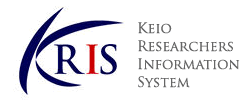-
Affiliation
-
School of Medicine, Medical Education Center (Shinanomachi)
-
Position
-
Professor

KEIO RESEARCHERS INFORMATION SYSTEM |
Details of a Researcher
このページはJavascriptを使用しています。すべての機能を使用するためにはJavascript を有効にする必要があります。
Monkawa, Toshiaki
|
|
School of Medicine, Vice Dean
Keio Information Technology Center, Deputy Director
教学マネジメント推進センター, Deputy Director
慶應義塾大学病院内科研修医
学術振興会特別研究員(PD)
慶應義塾大学医学部助手(医学部)
Division of Nephrology, University of Washington Research Fellow
慶應義塾大学医学部腎臓内分泌代謝内科助手
Keio University, School of Medicine
University, Graduated
Keio University, Graduate School, Division of Medicine, 内科学
Graduate School, Completed, Doctoral course
医師免許, 1991.05
日本内科学会認定内科医, 1996.09
労働衛生コンサルタント(保健衛生), 1998.06
日本腎臓学会腎臓専門医, 2003.04
日本透析医学会専門医, 2005.04
Interprofessional education,
医学教育学,
electrolyte, acid-base disorder,
development and induction of renal tubular cells,
ハルペリン 病態から考える電解質異常
Kamel S. Kamel、Mitchell L. Halperin著、門川俊明 翻訳, メディカルサイエンスインターナショナル, 2018.06
なぜパターン認識だけで腎病理は読めないのか?
MONKAWA TOSHIAKI, 医学書院, 2017.05
電解質輸液塾
MONKAWA TOSHIAKI, 中外医学社, 2013.04
レジデントのための血液透析患者マネジメント
MONKAWA TOSHIAKI, 医学書院, 2011.06
研究留学術
MONKAWA TOSHIAKI, 医歯薬出版, 2002.07
Yoshida R., Mitsuno R., Nakayama T., Azegami T., Hashiguchi A., Torimitsu T., Yoshimoto N., Hisikawa A., Hagiwara A., Nakamura T., Meguro S., Katsumata M., Endo J., Matsunaga T., Yoshino J., Kanda T., Morimoto K., Monkawa T., Yoshida T., Nakahara J., Yamaguchi S., Hayashi K.
Cen Case Reports 14 ( 3 ) 366 - 373 2025.06
Water and electrolyte abnormalities in novel pharmacological agents for kidney disease and cancer
Terashita M., Yazawa M., Murakami N., Nishiyama A., Tominaga N., Electrolyte Winter Seminar Collaborative Group , Sumi H., Shimizu H., Shibagaki Y., Ryuge A., Ogata M., Nagahama M., Monkawa T., Kawada K., Hirose K., Fujita Y., Fujimaru T.
Clinical and Experimental Nephrology 29 ( 5 ) 521 - 533 2025.05
ISSN 13421751
Mitsuno R., Nakayama T., Morimoto K., Uchiyama K., Washida N., Kusahana E., Hama E.Y., Tonomura S., Yoshimoto N., Hishikawa A., Hagiwara A., Azegami T., Yoshino J., Monkawa T., Yoshida T., Yamaguchi S., Hayashi K.
Blood Purification 54 ( 3 ) 174 - 183 2025.04
ISSN 02535068
Treatment of hyponatremia: comprehension and best clinical practice
Sumi H., Tominaga N., Fujita Y., Verbalis J.G., Yazawa M., Terashita M., Shimizu H., Shibagaki Y., Ryuge A., Ogata M., Nagahama M., Monkawa T., Kawada K., Hirose K., Fujimaru T.
Clinical and Experimental Nephrology 29 ( 3 ) 249 - 258 2025.03
ISSN 13421751
Sumi H., Tominaga N., Fujita Y., Verbalis J.G., Yazawa M., Terashita M., Shimizu H., Shibagaki Y., Ryuge A., Ogata M., Nagahama M., Monkawa T., Kawada K., Hirose K., Fujimaru T.
Clinical and Experimental Nephrology 29 ( 2 ) 134 - 148 2025.02
ISSN 13421751
Master regulatory factors for regeneration and EMT of kidney tubular cells
Monkawa, Toshiaki
科学研究費補助金研究成果報告書 2017
Monkawa, Toshiaki
科学研究費補助金研究成果報告書 2015
Monkawa, Toshiaki
科学研究費補助金研究成果報告書 2014
Monkawa, Toshiaki
科学研究費補助金研究成果報告書 2011
慶應義塾大学における海外施設での臨床実習プログラム
MONKAWA TOSHIAKI
第49回日本教育学会大会,
Oral presentation (general)
もう一度やり直す腎生理
MONKAWA TOSHIAKI
第46回日本腎臓学会東部学術大会,
Symposium, workshop panel (public)
タブレット端末iPad配付と教学システムのデジタル化
MONKAWA TOSHIAKI
第48回日本教育学会大会,
Oral presentation (general)
腎臓専門医制度 腎臓専門医(内科)のカリキュラム
MONKAWA TOSHIAKI
第59回日本腎臓学会学術大会,
Symposium, workshop panel (public)
K代謝異常
MONKAWA TOSHIAKI
第25回臨床内分泌代謝アップデート,
Symposium, workshop panel (nominated)
Master regulatory factors for regeneration and EMT of kidney tubular cells
MEXT,JSPS, Grant-in-Aid for Scientific Research, Grant-in-Aid for Scientific Research (C), Principal investigator
Best Teacher
2015.03, Keio University School of Medicine
日本内科学会奨励賞
MONKAWA TOSHIAKI, 2004.04, 日本内科学会
Type of Award: Award from Japanese society, conference, symposium, etc.
SYMPTOMATOLOGY
2025
PATHOPHYSIOLOGICAL ISSUES IN CHRONIC CARE
2025
MEDICAL PROFESSIONALISM 4
2025
MEDICAL PEDAGOGY: SEMINAR
2025
MEDICAL PEDAGOGY: PRACTICE
2025
選択臨床実習
Keio University
Full academic year, Laboratory work/practical work/exercise
診断学実習
Keio University
Full academic year, Laboratory work/practical work/exercise, Within own faculty
地域基盤型臨床実習
Keio University
Full academic year, Laboratory work/practical work/exercise, Within own faculty, 110people
CLINICAL REASONING
Keio University
Full academic year, Laboratory work/practical work/exercise, Within own faculty, 118people
CLINICAL TRAINING IN DIAGNOSIS
Keio University
Full academic year, Laboratory work/practical work/exercise, Within own faculty, 118people
なぜパターン認識だけで腎病理は読めないのか?
, Development of Textbook and Teaching Material
Denkaishitsu-Yueki-Juku
, Development of Textbook and Teaching Material
Management of hemodialysis patient for residents
, Development of Textbook and Teaching Material
Interprofessional education at Keio University
, Special Affairs
日本腎臓学会,
日本透析医学会
日本内科学会
日本医学教育学会,
理事, 日本医学教育学会
理事, 日本腎臓学会
評議員, 日本腎臓学会
representative, 日本医学教育学会
Editor, 医学中央雑誌